If You Build it, They Will Come
Back to Contents of Issue: August 2003
|
|
|
|
by Tim Hornyak |
|
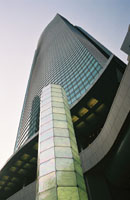 TAKE A WALK AROUND downtown Tokyo these days and "recession" isn't the first word that leaps to mind. Swanky European luxury goods boutiques seem to be raining down on the boulevards of Omotesando and Ginza, while groves of skyscrapers shoot out of the ground at nodes in the Yamanote loop line. In the deep freeze of Japan's economic slump, Tokyo is witnessing one of the largest construction booms since World War II.
Probably the most impressive of these redevelopment projects is Shiodome, a futuristic 31-hectare slice of business, residential and commercial waterfront on Tokyo Bay, nestled between bustling Shimbashi Station, Ginza and the tranquil Hama-rikyu Garden, an old shogunal hunting preserve. The greenery and tidal pools are dramatically set off by a clutch of high rises punctuated by leading ad agency Dentsu's new headquarters, a titanic wedge of glass by French architect Jean Nouvel that opened in December.
True to its postmodern design, True to its postmodern design, Shiodome is a disorienting array of intersecting midair walkways, sunken plazas and underground thoroughfares that will connect offices, restaurants, shops, condos and hotels. Girded by rail and subway lines, a highway and a monorail, it's also a city within a city that is to become a workplace for 61,000 and a home for 6,000 featuring JPY146.3 billion in infrastructure such as roads and parks paid for by the Tokyo metropolitan government. By its completion in 2006, it is expected to have created 93,000 new jobs and economic benefits estimated at JPY1.6 trillion, part of JPY10 trillion in effects from redevelopment zones in Marunouchi, Roppongi, Shinagawa and elsewhere in the capital. But Shiodome isn't your average Japanese construction zone.
"We made a new town from zero," notes Kaoru Shimura, who manages Dentsu's Caretta Shiodome shopping mall, a retail-entertainment nexus attached to the agency's HQ. "That concept itself appeals to consumers."
From Marsh to Metropolis
The imposing design of the old Shimbashi Station, destroyed in the Great Kanto Earthquake of 1923, symbolized the country's modernization in an era when the rickshaw was Japan's most successful export vehicle. Today, a new ferro- concrete reproduction that houses cafŽs and a rail museum is dwarfed by the curved, 43-story Shiodome City Center, an emerald-green office tower developed by Mitsui Fudosan Co. and Alderney Investments Pte. of Singapore that is home to about 60 restaurants and shops, a cooking school and a Porcshe showroom.
The reborn Shiodome of the information age has been dubbed a "media jokamachi" (media castle town) for the concentration of media firms setting up shop here. Besides Dentsu, one of the largest ad agencies in the world, office buildings have been erected by Kyodo News, Japan's biggest newswire, and broadcaster Nippon Television Network.
A Mock Turtle Soup
"In the first six months, the number of visitors as well as sales have exceeded our estimates by nearly 20 percent," he adds, noting on average over 200,000 people come through the mall every week. They vary from businessmen to foreign tourists to families and couples.
Riding the Money Train
"It's not that difficult to find tenants "What's going on in the property market is another form of Japanese momentum investment, and it's being driven by low market returns," says independent financial analyst Stephen Church, head of Analytica Japan. "It's people searching for yield. It just so happens that a lot of sites have become available."
While the country's abnormally low interest rates and bond returns may be driving institutional and individual investors to sink funds into real estate, Church says the property bubble is a reflection of underlying distortions in the economy such as the bad loan crisis.
"The problem is, in the current Japanese economy, with a flat nominal GDP and deflationary undertow, you're not guaranteed rental tenants," he adds, pointing to the fears that a good chunk of the Shiodome City Center would be vacant after a merger between prospective tenants Mitsui Chemicals Inc. and Sumitomo Chemical Co. fell through. Mitsui Fudosan has since said its chemical peer in the powerful Mitsui conglomerate will rent most of the space.
With the rush of tenants into the redevelopments and the huge volume of office space that has entered the market, observers have discussed the "2003 problem" of buildings in other parts of Tokyo being left unoccupied. At the end of last March, the vacancy rate of office buildings in the five wards of central Tokyo hit a post-bubble high of 8.18 percent.
"It's not that difficult to find tenants for new buildings because the technology is so different," says Fred Takahashi of Shiodome lead developer Sumitomo Realty & Development Co., which is erecting three structures on the site, including one that will be Japan's tallest residential tower at 190 meters and a 37-story building that will house the luxurious St. Regis Tokyo hotel of the US Starwood chain, where suites will cost JPY50,000 to JPY100,000 a night. He says most of the 2003 vacancy problem was concentrated in the first three months of the year and he's glad it's over.
Some critics have said the fact that Shiodome is bound by a highway and railway will limit its growth, but Takahashi believes the transport access is what sets the complex apart from rival developments.
"It's very competitive," he adds. "Marunouchi is a very dry part of the city without greenery or hotels. It has Tokyo Station, but the transport is just as good at Shimbashi. Roppongi Hills only has the subway, and transport is sub-par. Japan Railways is the main artery for transport in Japan with its large network."
As a railway cargo terminal, Shiodome played a crucial role in Japan's extraordinary modernization in the 20th century following its long feudal age. What was once the last stop on a line that extended to the port of Kobe is now a brash new beginning in the protean environment of Tokyo and the lifestyles of its residents. @
|
|
Note: The function "email this page" is currently not supported for this page.


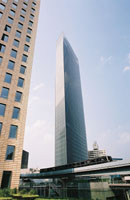 While the other projects have been grafted onto preexisting commercial or office zones, for years the Shiodome site was a disused freight terminal owned by the defunct Japan National Railways, which was privatized in 1987. Originally an area of marshy reeds and tidal flats, Shiodome, which means "tide stopper," was reclaimed under the shogunate and a sluice gate was installed to regulate the flow into the outer moat of Edo Castle. After the Meiji Restoration, it ushered Japan into the steam age with the country's first railway, linking Shimbashi and Yokohama, with the mikado himself presiding over the 1872 inauguration.
While the other projects have been grafted onto preexisting commercial or office zones, for years the Shiodome site was a disused freight terminal owned by the defunct Japan National Railways, which was privatized in 1987. Originally an area of marshy reeds and tidal flats, Shiodome, which means "tide stopper," was reclaimed under the shogunate and a sluice gate was installed to regulate the flow into the outer moat of Edo Castle. After the Meiji Restoration, it ushered Japan into the steam age with the country's first railway, linking Shimbashi and Yokohama, with the mikado himself presiding over the 1872 inauguration.
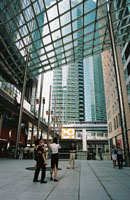 Over at Caretta Shiodome, about 50 customers are lined up outside Kyoto tea shop Tsujiri, one of its 56 stores, not far from a gulch-like plaza where passersby puzzle over an exhibit of surrealistic sculptures by French artist Niki de Saint Phalle. An artificial geyser spouts from a huge rock tortoiseshell nearby, drawing more onlookers. "Caretta" comes from caretta caretta, the scientific name of the loggerhead turtle, a symbol of longevity and luck as well as the totem of the new "slow life" approach to urban living. Around the corner at the 1,200-seat Dentsu Shiki Theatre SEA, the cast for Broadway musical "Mamma Mia" is warming up while concert-goers browse through photos of Japanese neon signs of yore at Advertising Museum Tokyo, where admission is free. Forty-seven floors up, all the tables are booked at Milanese restaurant Bice, which commands an excellent view of the bay and the lights of Odaiba and Ginza. The commercial and cultural synergies of this corner of the Shiodome complex make for a fine mŽlange, says Shimura.
Over at Caretta Shiodome, about 50 customers are lined up outside Kyoto tea shop Tsujiri, one of its 56 stores, not far from a gulch-like plaza where passersby puzzle over an exhibit of surrealistic sculptures by French artist Niki de Saint Phalle. An artificial geyser spouts from a huge rock tortoiseshell nearby, drawing more onlookers. "Caretta" comes from caretta caretta, the scientific name of the loggerhead turtle, a symbol of longevity and luck as well as the totem of the new "slow life" approach to urban living. Around the corner at the 1,200-seat Dentsu Shiki Theatre SEA, the cast for Broadway musical "Mamma Mia" is warming up while concert-goers browse through photos of Japanese neon signs of yore at Advertising Museum Tokyo, where admission is free. Forty-seven floors up, all the tables are booked at Milanese restaurant Bice, which commands an excellent view of the bay and the lights of Odaiba and Ginza. The commercial and cultural synergies of this corner of the Shiodome complex make for a fine mŽlange, says Shimura.
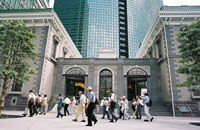 The commotion at Shiodome is reminiscent of Japan's high-growth era following the war, but it seems especially perplexing when compared to shuttered shotengai shopping streets in the unfashionable wards of the capital, not to mention glacial commerce in rural communities. It and other long-term redevelopment schemes are the fruit of planning that began before Japan's asset bubble; they are also related to recent government promotion of urban revitalization to prod the deflationary economy to life again. In 1996, Tokyo greatly eased building capacity ordinances, paving the way for skyscraper growth. In July 2002, Prime Minister Junichiro Koizumi's urban renaissance panel decided to ease regulations for 17 zones throughout the country in hopes of fostering growth and attracting JPY5 trillion in private investment. The JNR privatization settlement also brought enormous land plots onto the market, resulting in a property development boom and sites like Shiodome.
The commotion at Shiodome is reminiscent of Japan's high-growth era following the war, but it seems especially perplexing when compared to shuttered shotengai shopping streets in the unfashionable wards of the capital, not to mention glacial commerce in rural communities. It and other long-term redevelopment schemes are the fruit of planning that began before Japan's asset bubble; they are also related to recent government promotion of urban revitalization to prod the deflationary economy to life again. In 1996, Tokyo greatly eased building capacity ordinances, paving the way for skyscraper growth. In July 2002, Prime Minister Junichiro Koizumi's urban renaissance panel decided to ease regulations for 17 zones throughout the country in hopes of fostering growth and attracting JPY5 trillion in private investment. The JNR privatization settlement also brought enormous land plots onto the market, resulting in a property development boom and sites like Shiodome.
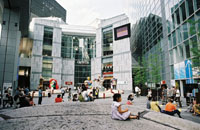 His firm hasn't started the marketing yet, but Takahashi says prospective office tenants are being drawn by more versatile air conditioning systems, better electricity supply to power computer equipment and enhanced security features. On the residential side, La Tour Shiodome on the far southwestern end of Shiodome will have larger windows in its leased units, a 24-hour bilingual front desk and a gym.
His firm hasn't started the marketing yet, but Takahashi says prospective office tenants are being drawn by more versatile air conditioning systems, better electricity supply to power computer equipment and enhanced security features. On the residential side, La Tour Shiodome on the far southwestern end of Shiodome will have larger windows in its leased units, a 24-hour bilingual front desk and a gym.



